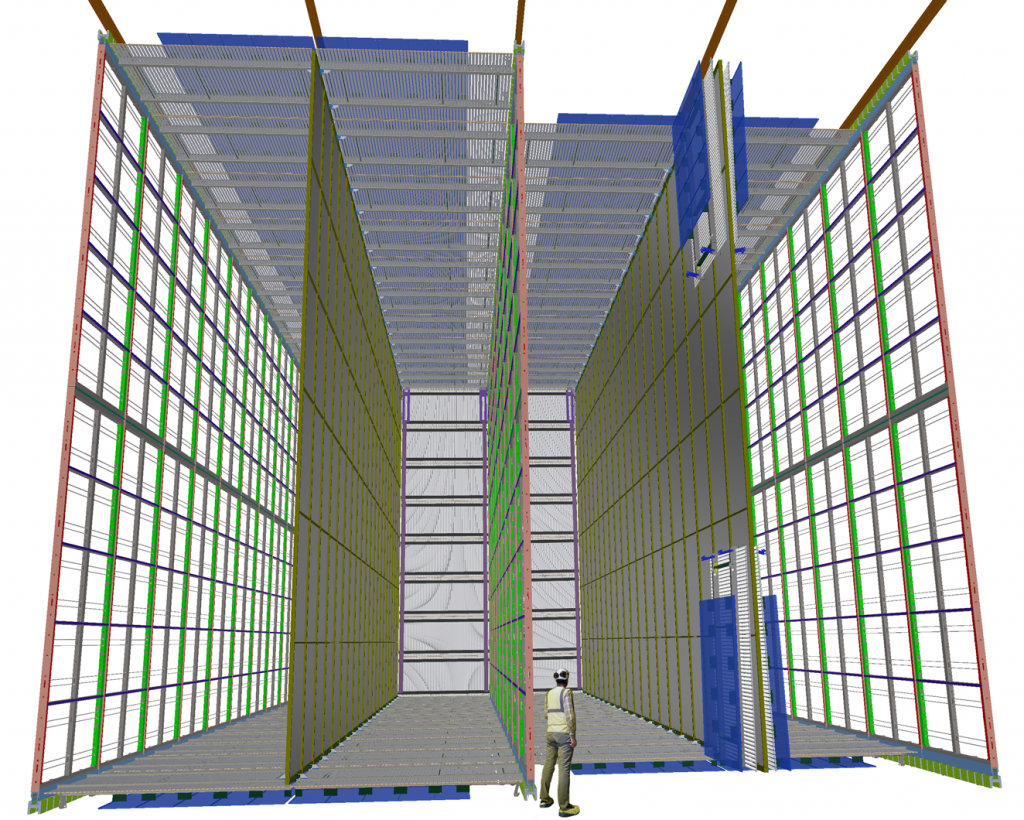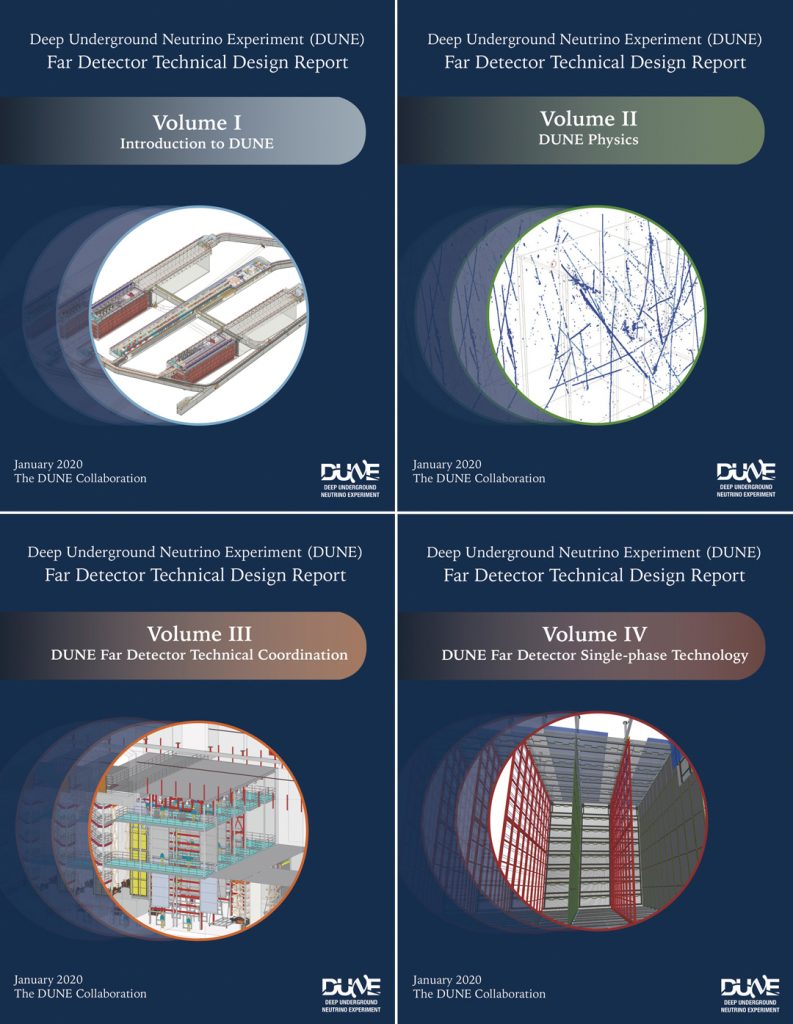After two years of work and contributions from hundreds of people, scientists now hold in hand the blueprint for perhaps the most ambitious neutrino experiment in the world.
Collaborators on the international Deep Underground Neutrino Experiment, hosted by the Department of Energy’s Fermilab, have published today its Technical Design Report. The document lays out everything needed to build the gigantic far detector, the largest of its kind ever built.
“It’s like the ultimate user manual,” said Fermilab scientist Sam Zeller, who served as the co-editor of the document together with Tim Bolton of Kansas State University. “Another team could come in and, based on that document, build the experiment — or at least have a start at it.”
More than 1,000 scientists from over 30 countries are working on DUNE, which is designed to explore mysteries surrounding fundamental particles called neutrinos. These tricky particles could have played a major role in how the universe evolved to be full of matter today. To examine their interactions with matter in greater detail than any other experiment, DUNE will use the world’s most powerful neutrino beam to send neutrinos 800 miles (1,300 kilometers) from Fermilab in Illinois to the Sanford Underground Research Facility in South Dakota — the longest distance of any experiment with man-made neutrinos. Precision measurements with particle detectors at Fermilab and approximately one mile (1.5 kilometers) underground at Sanford Lab aim to reveal potential differences in the behavior of neutrinos and their antimatter counterparts, antineutrinos. Understanding exactly how the particles change on their long journey through earth will give physicists clues about the history of our universe.

The DUNE Technical Design Report is the ultimate blueprint for building the experiment, providing all the details for constructing the giant detector modules. Shown here are the wire detection planes inside one of the modules. Image: DUNE collaboration
DUNE scientists will also be able to watch for neutrinos stemming from a supernova, which may go on to form a neutron star or black hole. Another goal of DUNE is to look for signals from a rare subatomic process known as proton decay. Shielded from cosmic radiation by a mile of rock, DUNE’s precise measurements of particle tracks will allow scientists to investigate whether protons live forever or eventually fall apart, bringing us closer to fully understanding the fundamental forces of nature.
Neutrinos (as well as antineutrinos) are notoriously tricky to study, passing through most matter without leaving a trace. To catch as many of them as possible, scientists use intense neutrino beams and build enormous detectors. The four massive DUNE far detector modules will be assembled like ships in a bottle, deep below the South Dakota soil. Each module will be longer than an Olympic-size swimming pool and four stories tall. Together, they will hold 70,000 tons of liquid argon, a crystal clear material that is ideal for the detailed measurement of neutrino interactions.
Completing the Technical Design Report required running enormous amounts of simulations, vetting the data recording and analysis process and ultimately making decisions about how to build the project.
“We’ve reached a big technical and scientific goal,” said DUNE co-spokesperson Stefan Söldner-Rembold, professor at the University of Manchester in the UK. “This means that the planning stage is done and we’re moving fully into the construction phase of the experiment.”
Preparations for the construction are already in full swing. Digging out a cavern to hold the massive far detectors requires moving around 800,000 tons of rock, and pre-excavation activities at Sanford Lab began with a mile-deep underground groundbreaking in 2017. Fermilab also broke ground in Illinois on both the near site preparation work and the construction of a new particle accelerator (the PIP-II accelerator project) in 2019. Scientists also built two house-sized prototype detectors, named ProtoDUNE, at CERN to test all systems before finalizing this TDR. With the final report in hand, international partners can start building the components for the experiment itself.
“This is what the collaboration has been working toward for so long,” said Ana Amelia Machado, a researcher working on the ARAPUCA light detection system for DUNE at the University of Campinas in Brazil. “There have been so many innovative ideas — we’re excited to take what we’ve learned from prototyping and start building this experiment.”

The DUNE Technical Design Report is broken into different volumes, and the DUNE collaboration has released the first four of five volumes. They cover the physics, the technical coordination and the two argon technologies chosen for the giant far detector modules: the single- and dual-phase.
The report is so meaty, it must be broken up into different volumes. The collaboration has released the first four of five volumes, combined coming in at around a whopping 570,000 words. That’s a “War and Peace” worth of scientific information.
There is a volume each dedicated to an introduction, the physics, the technical coordination, and one for each of the two argon technologies chosen for the giant far detector modules: the single- and dual-phase. The single-phase volume reflects the information learned in one ProtoDUNE testbed and lays out the design for how DUNE’s first far detector module will be constructed. The upcoming fifth volume will cover the dual-phase technology, which uses both liquid and gaseous argon. It will be finalized based on input from the operation of the dual-phase ProtoDUNE detector at CERN. DUNE collaborators are also preparing a conceptual design report for the near detector and a TDR for the software and computing designs.
“Everything that we’ve built so far has been practice for scaling up to DUNE,” said collaborator Albert de Roeck, leader of the CERN experimental neutrino group. “We’ve tested the technologies, figured out how to coordinate people from hundreds of institutions and started setting up the assembly lines to make the things we need. It’s going to be a carefully organized dance, and we’re ready to go.”
The four volumes of the DUNE Far Detector Technical Design Report published today are available online: Volume One (Introduction), Volume Two (Physics), Volume Three (Technical Coordination), Volume Four (Single-phase technology).
The DUNE collaboration comprises more than 180 institutions from 30-plus countries. To learn more about the Deep Underground Neutrino Experiment, the Long-Baseline Neutrino Facility that will house the experiment, and the PIP-II particle accelerator project at Fermilab that will power the neutrino beam for the experiment, visit www.fnal.gov/dune.
This work is supported by the U.S. Department of Energy Office of Science.



